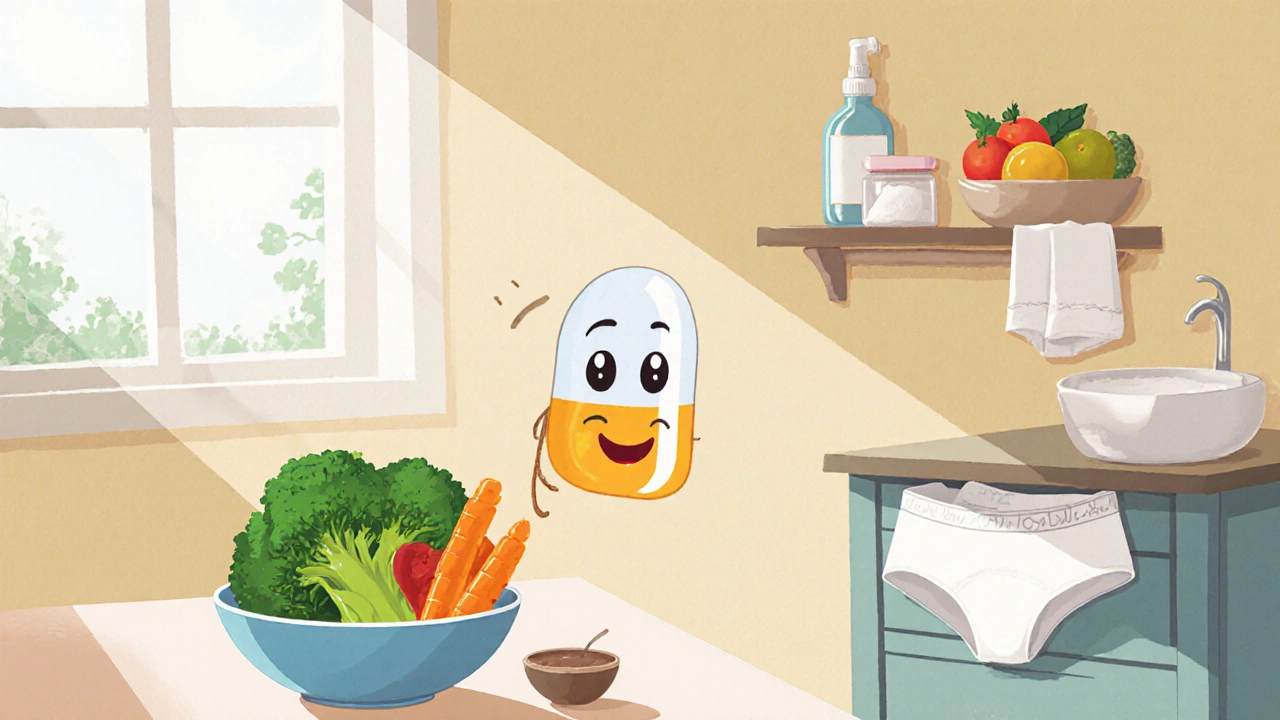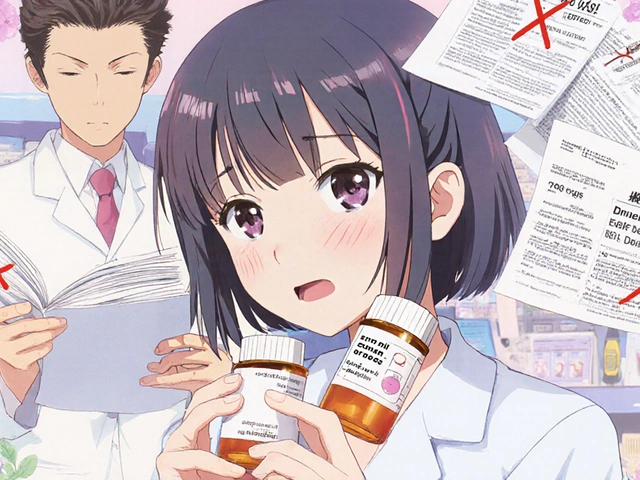
Yeast Infection Symptom Checker
This tool helps you identify whether your symptoms might indicate a yeast infection related to antibiotic use. Remember: This is for informational purposes only and does not replace professional medical advice. If symptoms persist or worsen, consult a healthcare provider.
Symptoms
Select symptoms you're experiencing. Multiple symptoms increase the likelihood of a yeast infection.
Results
Key takeaways:
- Cefdinir can disrupt normal gut flora, opening the door for Candida overgrowth.
- Typical yeast infection signs differ by location - look for itching, white discharge, or white patches.
- Probiotics, low‑sugar diet and proper hygiene are the easiest ways to keep yeast in check while on antibiotics.
- If symptoms appear, early treatment with over‑the‑counter antifungals can prevent spreading.
- Always discuss antibiotic length and alternatives with your prescriber.
What is Cefdinir?
Cefdinir is a third‑generation oral cephalosporin antibiotic often prescribed for respiratory infections, skin infections and ear infections. It works by blocking bacterial cell‑wall synthesis, which kills the bacteria. Typical adult dose is 300mg once or twice daily for 5‑10days, but the exact regimen depends on the infection type.
Why antibiotics like Cefdinir can lead to yeast problems
Antibiotics aren’t picky; they attack both harmful bacteria and the good ones that live in your gut. When the balance tips, Candida albicans-the yeast that normally lives harmlessly on skin and mucous membranes-can multiply unchecked. This phenomenon is called antibiotic‑associated candidiasis.
The gut microbiome acts like a security team. Beneficial bacteria compete for nutrients, produce acids that keep yeast in a dormant state, and stimulate the immune system. Strip away those allies with a broad‑spectrum drug, and Candida gets a free pass.
Common yeast infections you might notice
Yeast loves warm, moist environments, so it shows up in a few predictable places:
- Vaginal candidiasis - itching, burning, a thick white “cottage‑cheese” discharge.
- Oral thrush - white patches on the tongue or inner cheeks that can’t be scraped off easily.
- Cutaneous candidiasis - red, moist rash in skin folds, often in the groin or under breasts.
- Invasive candidiasis - a rare but serious bloodstream infection, usually in people with weakened immune systems.

Spotting the symptoms early
Because the signs differ by location, keep an eye on these cues while you’re on Cefdinir or any other antibiotic:
- Itching or burning sensation in the genital area.
- Unusual discharge that’s white, clumpy, and doesn’t have a strong odor.
- White patches on the mouth that bleed when scraped.
- Red, moist skin patches that worsen after sweating.
- General fatigue or an unexplained fever (could suggest a deeper infection).
If you notice any of these within a few days of finishing a course, consider a preventive step rather than waiting for the problem to worsen.
How to prevent yeast overgrowth while taking antibiotics
There’s no magic pill, but a combination of lifestyle tweaks and supplemental support can keep Candida at bay.
| Method | How it works | Typical use |
|---|---|---|
| Probiotic supplement | Replenishes beneficial bacteria that compete with Candida | Take a multi‑strain capsule (e.g., Lactobacillusrhamnosus, Bifidobacteriumlongum) once daily, start 2days before antibiotic and continue 2weeks after |
| Low‑sugar, low‑refined‑carb diet | Reduces the food source Candida feeds on | Limit sweets, white bread, fruit juices while on medication; focus on vegetables, protein, whole grains |
| Good hygiene & moisture control | Prevents the warm, damp environments yeast likes | Change out of sweaty clothes promptly, wear breathable cotton underwear, use gentle antifungal powders if prone to skin folds |
| Antifungal prophylaxis (rare) | Directly suppresses yeast growth | Prescribed only for high‑risk patients (e.g., immunocompromised); not typical for most users |
Here’s how to put the plan into practice:
- Start probiotics early. Choose a product with at least 10billion CFU and multiple strains. If you have a dairy intolerance, go for a soy‑based or spore‑forming probiotic.
- Watch your sugar intake. Even natural sugars in fruit can feed Candida, so keep fruit portions moderate and pair them with protein or fat.
- Stay dry. After showering, pat skin dry, especially between toes and in the groin. Consider using a talc‑free powder if you tend to sweat a lot.
- Don’t self‑medicate with antifungals unless advised. Over‑the‑counter creams (like clotrimazole) are fine for mild cases, but using them preventively without a diagnosis can cause resistance.
- Talk to your prescriber. If you’ve had recurrent yeast infections, ask whether a shorter course or a different antibiotic class is possible.
Treatment options if infection appears
Most superficial yeast infections clear up with topical antifungals applied twice daily for 7‑14days. Common agents include clotrimazole, miconazole, and terbinafine. For oral thrush, a short course of nystatin suspension or fluconazole tablets works well.
When the infection is more persistent-lasting beyond two weeks despite treatment-or when you have risk factors like diabetes, it’s worth getting a culture. A doctor might prescribe a higher dose oral fluconazole or another systemic antifungal.

When to seek professional help
If you experience any of the following, book an appointment promptly:
- Fever or chills along with yeast‑related symptoms.
- Severe pain, swelling, or discharge that’s not improving.
- Repeated infections despite using probiotics and topical treatments.
- Pregnancy-some antifungals are not recommended.
Early intervention keeps the infection from spreading to other body sites or becoming systemic.
Bottom line
Cefdinir is a powerful tool against bacterial infections, but it can unintentionally give yeast a free ride. By understanding the link, watching for symptoms, and taking simple preventive steps-probiotics, smart diet, and good hygiene-you can stay one step ahead of Candida. If symptoms do surface, swift treatment usually clears things up without drama.
Frequently Asked Questions
Can I take probiotics while on Cefdinir?
Yes. Probiotics won’t interfere with the antibiotic’s action and can help restore healthy gut bacteria. Start a day before the antibiotic and continue for at least two weeks after finishing the course.
How long does it take for a yeast infection to develop after finishing antibiotics?
Symptoms often appear within a few days to a week after completing the antibiotic, but the window can extend up to three weeks depending on individual microbiome resilience.
Are there any foods that can trigger yeast overgrowth?
High‑sugar foods, refined carbs, and excessive alcohol provide food for Candida. Cutting back on sweets, white bread, and sugary drinks helps keep yeast levels low.
Is it safe to use over‑the‑counter antifungal creams while still on Cefdinir?
Yes, topical creams like clotrimazole are safe to use alongside antibiotics. They act locally and don’t affect the antibiotic’s efficacy.
What should I do if I’m pregnant and need Cefdinir?
Pregnant women should discuss risks with their doctor. Cefdinir is generally considered safe in pregnancy, but alternative antibiotics may be chosen if yeast infection risk is high.






There are 15 Comments
isabel zurutuza
Yeah antibiotics love to throw a party for yeast.
James Madrid
Probiotics are a solid move when you start a cefdinir course. I like to begin a day before the antibiotic and keep them going for a couple of weeks after. Pair that with a low‑sugar diet and you’ll give the good bacteria a fighting chance. Also, staying on top of personal hygiene helps keep skin‑fold infections at bay.
Justin Valois
Listen up, because the truth about cefdinir and yeast is wilder than a midnight horror flick.
When you pop that pill, you’re basically sending a demolition crew into your gut, blowing up the good bugs like they’re nothing.
The harmless Candida, which normally minds its own business, gets the green light to throw a rave in the empty space.
Imagine a city where the police vanish and the vandals run rampant – that’s your microbiome on broad‑spectrum antibiotics.
Soon enough you’ll feel the itch, the burn, the white discharge, and you’ll wonder if you accidentally signed up for a spa day for fungi.
Don’t be fooled by the “harmless yeast” myth; it can turn into an invasive nightmare if you give it a runway.
Probiotics are like the backup squad that tries to restore order, but they’re useless if you keep feeding the party with sugar.
Every sweet soda, every piece of white bread is like tossing confetti onto the dance floor.
And don’t even start on the “just use a cream” excuse – topical treatments are only band‑aid if the infestation has already set up camp.
If you’re prone to infections, your doctor should consider a shorter course or a different class, but many just shrug and write another prescription.
The pharmaceutical giants love this cycle; more antibiotics means more yeast, which means more over‑the‑counter antifungals they can sell.
It’s a perfect profit loop that keeps you reaching for the next bottle while your gut screams for balance.
So arm yourself with a multi‑strain probiotic, ditch the sugary snacks, and keep those groins dry – those are the real weapons.
If symptoms flare up, don’t wait for a fever to knock on your door; grab an OTC cream and schedule a doc visit ASAP.
Bottom line: respect the power of cefdinir, respect your microbiome, and don’t let Candida crash your party.
Jessica Simpson
From a broader health‑culture view, many traditional diets naturally keep Candida in check. Fermented foods like kimchi, kefir, and sauerkraut supply live cultures that compete with yeast. Incorporating those foods can be a tasty way to support your microbiome while on antibiotics.
Mauricio Banvard
Sure, the “natural diet” thing sounds wholesome, but ever notice how pharma pushes processed snacks while quietly selling probiotic pills? They profit from the very imbalance they help create. Keep an eye on what’s really being marketed.
Paul Hughes
Totally get that it’s a hassle, but a quick probiotic and a bit of extra dry time after showers can make a huge difference 😊 Stay chill and keep it simple.
Mary Latham
Honestly, i don’t think you need a probiotic for every round of abx. My gut’s fine with just cutting soda and watchin the sugar.
Marie Green
I hear you, dealing with a rash on top of a cold can feel overwhelming. It’s okay to take it step by step and reach out to a doc if things don’t improve.
TOM PAUL
Exactly! A bit of patience plus the right diet can turn the tide fast. Keep that energy up!
Ash Charles
Don’t hesitate to ask your prescriber about a shorter cefdinir course if you’ve had yeast issues before. Being proactive can save you a lot of discomfort.
Michael GOUFIER
In accordance with current clinical guidelines, a prophylactic probiotic regimen should be initiated prior to antimicrobial therapy and continued for a minimum of fourteen days post‑treatment to re‑establish intestinal flora equilibrium.
michael Mc Laughlin
Stay positive, keep the sugar low and the probiotics coming, you’ll beat the yeast.
Luke Schoknceht
Frankly, the entire discourse around cefdinir and yeast is a manufactured panic, churned out by marketers who thrive on consumer anxiety. They pepper every article with buzzwords like “microbiome” and “probiotic” to sell supplements that most people never truly need. Meanwhile, the average patient is left juggling a cocktail of antibiotics, creams, and dietary restrictions, all under the guise of “prevention.” It’s a classic case of over‑medicalization: a simple imbalance solved by a box of pills and a pricey yogurt. The scientific community could provide clearer guidelines, yet the profit motive overrides clarity. If you strip away the hype, the advice is basic-don’t overindulge in sugar, stay dry, and maybe take a probiotic if you feel it helps. Anything beyond that is just noise to keep the supplement industry afloat. So, before you panic, remember: it’s not a life‑threatening apocalypse, just an overgrown fungus looking for a snack.
mauricio gonzalez martinez
By the way, I saw you posted a picture of your pet hamster last week-cute!
Christian Freeman
One could argue that the battle between antibiotics and yeast mirrors the larger struggle between order and chaos within the body, reminding us that balance is a continual practice rather than a static state.
Write a comment
Your email address will not be published. Required fields are marked *